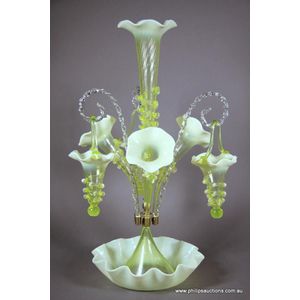Victorian Cranberry & Vaseline Glass Epergne with 7 Trumpets
You must be a subscriber, and be logged in to view price and dealer details.
Subscribe Now to view actual auction price for this item
When you subscribe, you have the option of setting the currency in which to display prices to $Au, $US, $NZ or Stg.
- Cranberry Glass - Cranberry glass is a type of glass that is characterized by its deep red color. It was first made in the 19th century and was particularly popular during the Victorian era. It was typically used to make decorative items such as vases and figurines. The red color was achieved by adding gold chloride or selenium to the glass mixture during the manufacturing process.
- Decor Bois - "Decor bois" is a French term that translates to "wood decor" in English. It refers to decorative elements painted on porcelain items that simulate decorations in timber, such as carvings.
- Finial - An architectural decoration, found on the upper parts of of an object. On furniture they are usually found on pediments, canopies and shelf supports. On smaller ceramic or silver items, such as spoons, they may decorate the top of the item itself, or the lid or cover where they provide a useful handle for removal.
Finials have a variety of shapes and forms. They may be urn-shaped, baluster shaped round or spiral, but usually taper into an upper point. Many real life shapes may also be used as finials, such as pineapples, berries, pinecones, buds, lotus and acorns. Sometimes animals such as a lion are depicted, or fish and dolphins. - Victorian Period - The Victorian period of furniture and decorative arts design covers the reign of Queen Victoria from 1837 to 1901. There was not one dominant style of furniture in the Victorian period. Designers used and modified many historical styles such as Gothic, Tudor, Elizabethan, English Rococo, Neoclassical and others, although use of some styles, such as English Rococo and Gothic tended to dominate the furniture manufacture of the period.
The Victorian period was preceded by the Regency and William IV periods, and followed by the Edwardian period, named for Edward VII (1841 ? 1910) who was King of the United Kingdom and the British Dominions and Emperor of India for the brief period from 1901 until his death in 1910.
This item has been included into following indexes:
Visually similar items

A cranberry and cased glass epergne, early 20th century, the epergne with five wavy edged trumpets and baskets, two spiral canes and trailing rigaree to a wavy edge squared base, height 53 cm

Victorian vaseline glass four trumpet epergne having five five trumpets & crimped rims. Condition: good, slightly loose. Height 46 cm

Victorian vaseline glass four trumpet epergne having seven trumpets & crimped rims. Height 56 cm

A Victorian vaseline glass epergne. second half 19th century, in striking creamy lemon to clear lime tones with a central floral trumpet with an internal spiral motif and trailing applied clear glass embellishments, three matching side trumpets and three b
